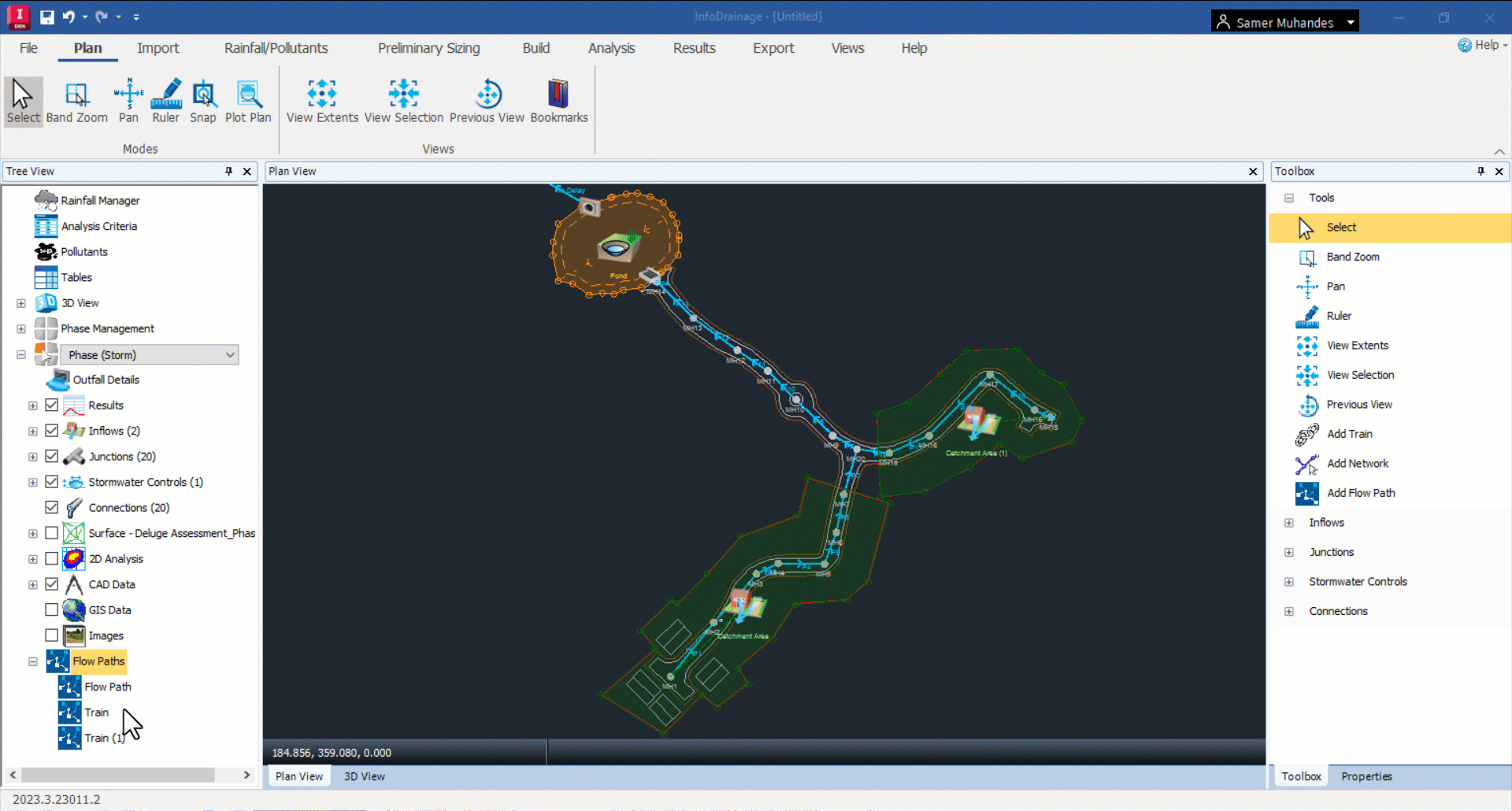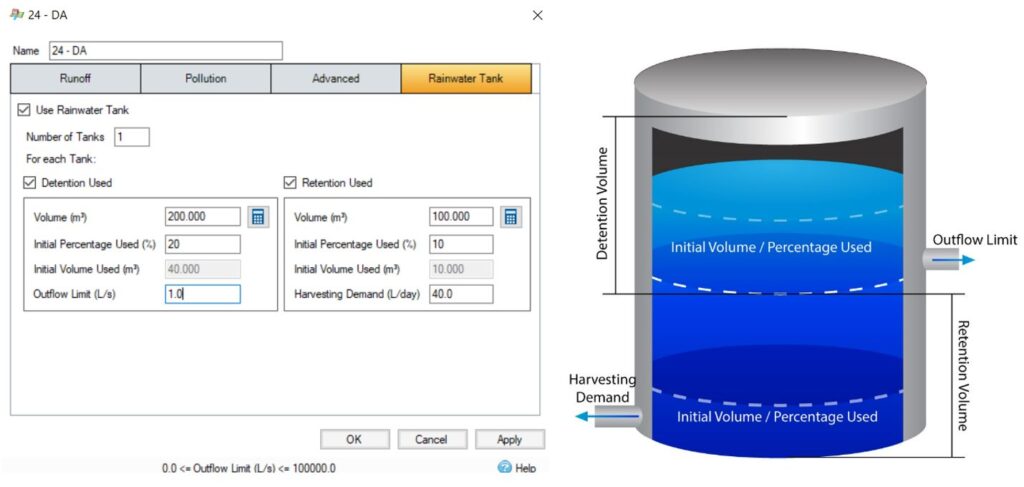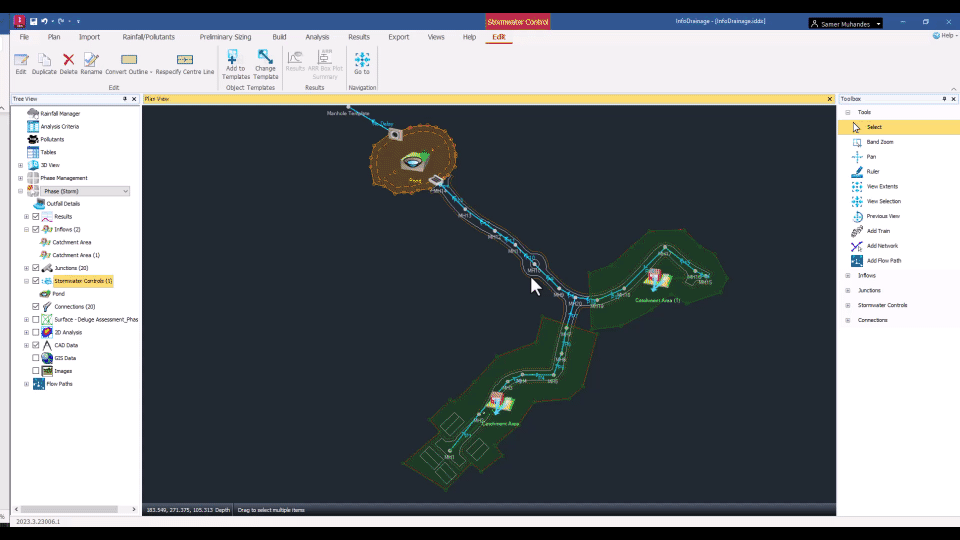Autodesk’s Storm and Sanitary Analysis (SSA) for Civil 3D is a dynamic hydrologic and hydraulic modelling software that assists in the design and analysis of stormwater systems, sanitary sewers, and other drainage systems. It enables engineers to predict the impact of new designs and changes, optimize system performance, and plan for extreme weather events. If you’ve been using SSA, you’ll know it’s a robust solution with many impressive features. But every software has its limitations, and that’s where InfoDrainage steps in.

You can try these 10 things yourself by downloading a 30-day free trial of InfoDrainage – no credit card required.
Simply put, there are some things you can do with InfoDrainage that you can’t do in SSA. From advanced GI modelling capabilities to user-friendly templates, InfoDrainage offers a range of tools that can help you push the boundaries of your water management projects. Whether you’re a seasoned professional or a novice in the field, this comparison will offer insightful information that could take your work to the next level.
Let’s dive in and discover what InfoDrainage has to offer.
1. More accurate representation of GI
In SSA, Green Infrastructure (GI) elements can be represented as storage nodes with no physical dimensions or footprint. This means that while the GI element volume is considered, the time of concentration of water flowing through various GI elements is not.

In InfoDrainage, we’ve made sure the actual physical dimensions of GI elements are spatially represented with advanced parameters to model the depth, porosity, and hydraulic conductivity of various filtration layers that may sit underneath a GI element. For example, if you need to represent gravel and sand underneath bioretention features, InfoDrainage has sharp accuracy when representing GI elements and is more capable of capturing hydraulic performance.

Consider these benchmarking results from a project related to Clayland Pond in Scotland that shows where the inlet and the outlet chambers of the pond were monitored during several rainfall events as part of the Scottish GI Monitoring Programme.

We used the observed inflow and injected the inflows as an input hydrograph at the upstream end of the Claytons Pond model in both SSA and InfoDrainage to replicate the storm event and compare the simulated outflow from both models against the observed monitored outflows (real-time data) from the flow monitor.
All results offer insight into possible scenarios, but InfoDrainage offered a closer match to observed flows.
2. Phase management tools
A good drainage design is one that has gone through an optioneering exercise with multiple iterations to exhaust all opportunities and identify the optimum location, volume, and type of storage structures that achieve the best results for the lowest cost possible.
In SSA, that kind of optioneering exercise means branching out a new model or creating multiple drainage models/files, running them all, exporting the results, comparing the simulation results in Excel or other data analysis tools, and then writing a report about the comparison outcome. This process can be incredibly time-consuming and sometimes cost-prohibitive. We’ve seen that this time penalty associated with optioneering often discourages drainage designers from iterating on the design or performing an optioneering exercise for every design.
InfoDrainage has an advanced Phase Management capabilities where users can simply duplicate their design and model/design various solutions (scenarios), run simulations for each solution and generate reports to compare the outputs from each Phase/Scenario. The image below compares the outflow between pre- and post-development following the introduction of paved surfaces in a greenfield site.

3. Allowable undos
The benefit of having an undo command in drainage design software is an important one that shouldn’t be discounted. It allows you to easily correct mistakes or make changes without starting the entire design process from scratch. Without an undo command, you need to manually reverse any changes you make, which is time consuming and can result in errors.
In SSA, you can track changes and roll back but you are not able to undo any actions you take immediately, whereas in InfoDrainage, you have the option not only to undo a certain action but also to specify the number of Allowable Undos, which enhances your own user experience and helps ensure a more efficient design process.

Having that undo option at your fingertips makes you more efficient and productive, but perhaps more importantly, it encourages experimentation. You can try different design options without fear of irreversibly damaging your entire design.
4. Object and project templates
SSA does not come with templates, but InfoDrainage has Project and Object Templates which can be created to provide a starting point for designers to use for multiple designs. You can design templates per client, per project, per country, etc.

5. Critical Storm Duration Analysis
Critical storm duration analysis is an important tool in drainage design because it allows engineers to understand how various storm durations and temporal patterns would stress or fail different parts of the drainage system.

In SSA, you need to analyse each storm individually to identify the critical storm based on a specific objective. This is a time-consuming task, especially if you are expected to run multiple return periods and storm durations for various temporal patterns. Simply put, you may need to analyse hundreds of storms to assess your drainage design, which can be daunting.
InfoDrainage includes a Critical Storm Duration Analysis tool, which helps you quickly determine the storm event that will cause the maximum flow rate, water level, or flood volume in each drainage element.
6. Validation before your analysis
In SSA, if an error stops the model from being simulated, you’ll see an error message directing you to a certain location where the error occurred. Then, you repeat this process until you have cleared all issues.

In InfoDrainage, you can use the built-in validation tool to provide a list of problematic errors and warnings that could be causing issues in the simulation so you can correct them. In some cases – for example, when issues are associated with levels – InfoDrainage will provide suggestions for a fix, giving you a list of suggestions to implement, letting you do it with the click of a button if possible.
7. Innovative design logic switch
InfoDrainage includes an innovative design logic switch tool that enables you to navigate between minimizing excavation and minimizing pipe diameter. This tool can make a significant difference in the design process as it allows you to switch between these two conflicting objectives. It’s been designed specifically to help you make more informed decisions about which design approach will be most effective for a particular project.

In SSA, you follow a specific design logic regardless of the specific requirements of the project. We think that this does not provide enough flexibility for most designers, and it doesn’t tailor your model to the unique needs of each project.
8. Model rainwater harvesting tanks
Harvesting rainwater sits at the top of the SuDS hierarchy. It’s the most sustainable practice when it comes to rainwater runoff and demand reduction. Unfortunately, rainwater harvesting is often bypassed by designers in SSA due to the uncertainty associated with modelling demand from the rainwater tank.

With InfoDrainage, you can model the effect of rainwater tanks on a sub-catchment level. This deep granularity allows you to specify the number of tanks, the volume of detention (for stormwater control) and retention, outflow from the detention compartment, and harvesting demand from the retention compartment. With this tool, you can test options for various demand values and size your rainwater harvesting tanks accordingly.
9. Extended Property Sets for better mapping with Civil 3D
In SSA, you can map elements from Civil 3D to SSA, but the process is neither frictionless nor bi-directional.
In InfoDrainage, you can start your design using Civil 3D elements and send your drainage elements directly to InfoDrainage to perform your hydraulic analysis. Or, you can start from InfoDrainage and export to Civil 3D to integrate your drainage design with your site design.

To avoid data loss during round-tripping between InfoDrainage and Civil 3D, we ensured that data present in InfoDrainage could be accessed in Civil 3D via Extended Property Sets so that it can be used in additional workflows, including costing and clash detection analysis. In InfoDrainage, you can not only expose the hydraulic/hydrology parameters of the pipes, subcatchments, and stormwater controls within Civil 3D; you can also manipulate some of the parameters within Civil 3D. We think that this functionality can be a game changer for drainage designers.
10. Flexibility for international projects
SSA was designed specifically for the US market with additions to allow for rainfall generation from IDF curves to facilitate working on international projects. But InfoDrainage can support your needs for international projects. It includes design rainfall, peak flow calculation, and runoff methods embedded in the software to deliver drainage design in the UK, France, USA, Germany, Spain, Middle East, China, Japan and Australia.

We’re always working on adding more details that are specific to more countries and regions to ensure designers around the world can deliver drainage designs that comply with their local regulations.

Download the InfoDrainage free trial
If you’re a Civil 3D user, SSA can help you accomplish a lot, but we think InfoDrainage can help you go deeper and work more efficiently. We see more and more people importing and exporting to and from Civil 3D, and we encourage that kind of back and forth.
Want to try it out yourself? Take advantage of our 30-day free trial – no obligation and no credit card required – and try this alternative to SSA. You can get started by following along with our video learning series, Introduction to InfoDrainage.